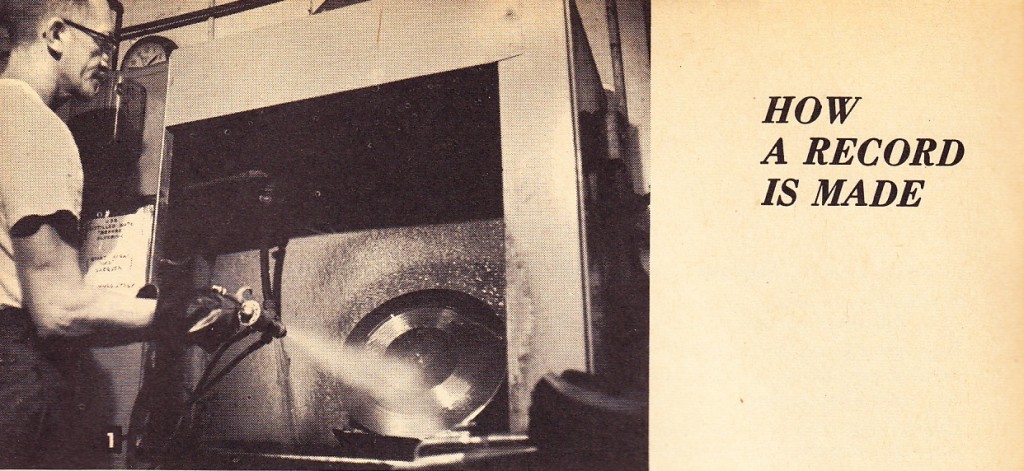
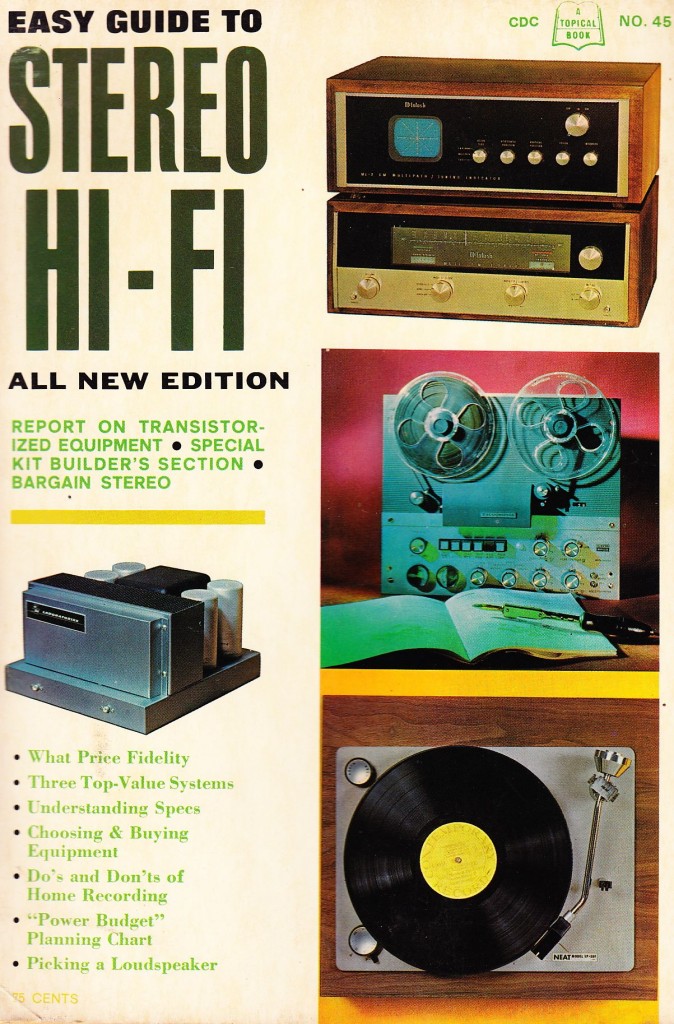 Today: From “Easy Guide To Stereo HiFi,” 1964, ed. Robert Mayfield: a short pictorial on the subject of ‘How a record is made.’ Nothing too exciting here; I am reproducing this primarily because the plant shown in the article is none other than the Bridgeport, CT Columbia Records plant. As I’ve mentioned before, this building is still standing; it is now ‘loft condos.’ The BPT Columbia plant was, AFAIK, the first facility in the world to manufacture 33rpm LP records; SCULLY, America’s top manufacturer of LP cutting lathes, was located a dozen blocks away, along the same train tracks that today still serve commuters, dotted with idled freight cars resting on derelict short-ends of tracks strewn throughout the East End.
Today: From “Easy Guide To Stereo HiFi,” 1964, ed. Robert Mayfield: a short pictorial on the subject of ‘How a record is made.’ Nothing too exciting here; I am reproducing this primarily because the plant shown in the article is none other than the Bridgeport, CT Columbia Records plant. As I’ve mentioned before, this building is still standing; it is now ‘loft condos.’ The BPT Columbia plant was, AFAIK, the first facility in the world to manufacture 33rpm LP records; SCULLY, America’s top manufacturer of LP cutting lathes, was located a dozen blocks away, along the same train tracks that today still serve commuters, dotted with idled freight cars resting on derelict short-ends of tracks strewn throughout the East End.
Categories

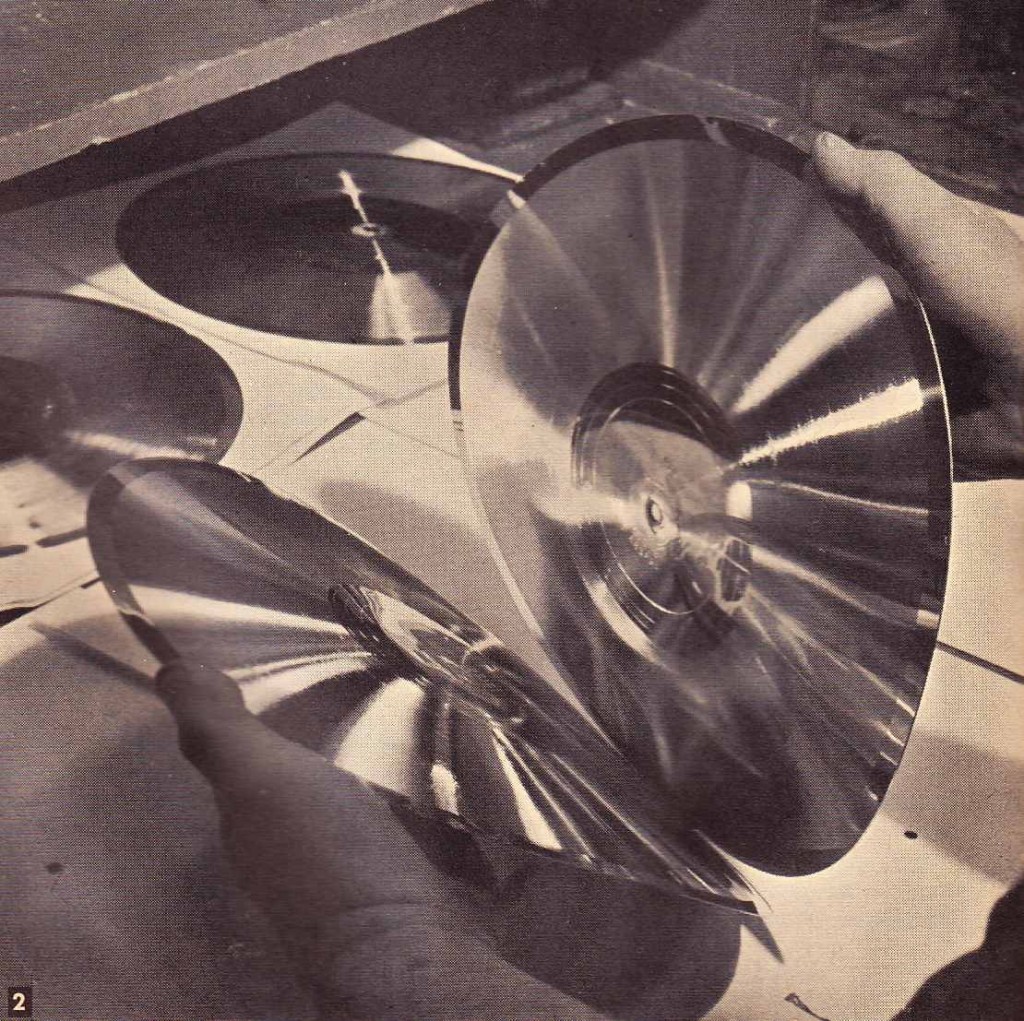
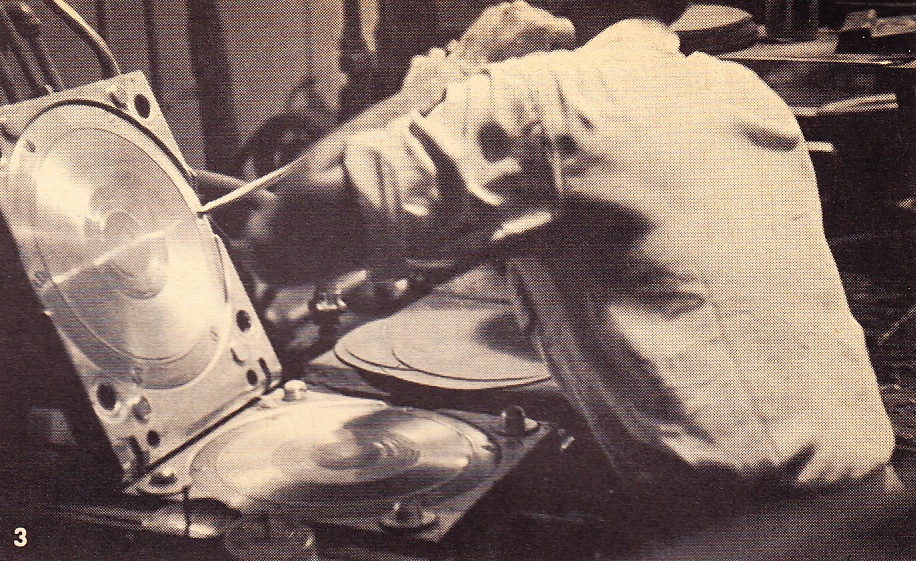
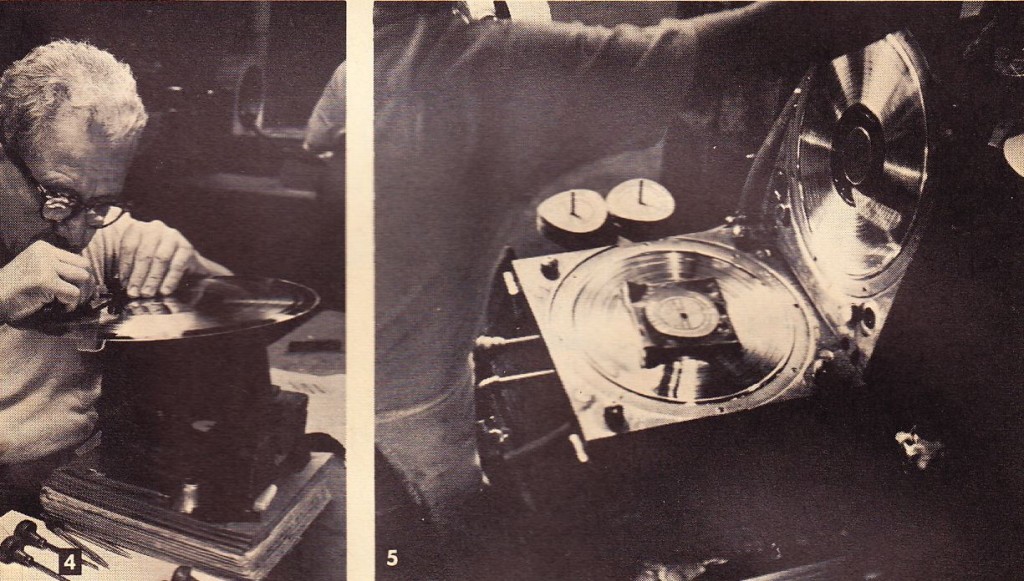
16 replies on “Bridgeport, CT Circa 1964”
I love these old magazines, unfortunately have had to throw thousands of them out over the years because of no space, moves, etc. These all need to be electronic so we can read them onscreen. Pete Millett has a lot of stuff, but mostly books, not magazines.
On the cover we see the McIntosh tuner with its separate oscilloscope display. Not a general purpose scope, but a stylish McGuffin for the well heeled broadcast listener, it also worked with other system units and could be used for much of the stuff a real scope could. It was cheaper than a Tek but more expensive than the 3″ simple scopes of the day.
We also see an early solid state power amp-I wonder what it is-and a nice looking turntable.
It was in late March, 1964, that Columbia shut down its Bridgeport plant, transferring all East Coast pressing activities (and manufacture of styrene 45’s) to their newer Pitman, NJ plant that first went into operation in May 1961 (and, sadly, closed in March 1981); the label typesetting associated with Bridgeport would also go to Pitman, though on Columbia, Epic and subsidiary releases, the Linotype fonts would not really reappear on a regular basis until summer 1965. Can anyone who knows anyone who once worked at the Bridgeport plant apprise as to what was the deal with the typesetting that was on the labels?
I would add to Mr. Fine’s comments that if the Bozak’s were relcaped by JBL Paragons or Hartsfields or upgraded (that T35 Avedon tweeter needs to go!) K-horns, and the caps and resistors upgraded on the electronics, he probably would consider the system his parents had to be fully as good as anything you could put together from Audio Research, conrad-johnson or Manley today. Rudy Bozak was a nice guy but his speakers do not hold up in terms of fidelity nearly as well as do Altec, JBL or Klipsch horn designs or Quad electrostats for that matter.
Correction: The Pitman plant ceased manufacturing vinyl in 1986-87, converted thereafter to CD manufacturing only, and shuttered in March 2011. (The 1981 was a typo.)
Could anyone confirm that there were no records pressed at Bridgeport after 1964?
We are discussing this for the ”Discogs” database.
Many thanks!
I can’t confirm but I think I remember making a “custom electronics” delivery to that plant back in 1974 …. emphasis on “I think I remember” ….
The Library of Congress has papers from the Columbia Bridgeport plant in terms of the many jobs they handled over the decades. The cutoff date, if based on the papers, was late March 1964 (the most recent Columbia single to be pressed by that plant, according to a PDF file from LOC as to the contents of those papers, was 4-43022 which was released March 31, 1964; the latest LP to be pressed by them was around February of that year). Many have erroneously cited the code “CT” as signifying the Bridgeport plant when, in fact, it was a code for Columbia’s Terre Haute, IN plant (as was ‘CTH’). (Besides, back when Columbia was pressing records in Bridgeport, the common abbreviation for the state was ‘Conn.’; ‘CT’ was not used as a state abbreviation until starting in the later 1970’s; furthermore, I saw a Bridgeport-pressed LP on United Artists from the early ’60’s where, written on the deadwax, was the code ‘CLB’.) Thereafter, all East Coast pressing was transferred to Pitman, NJ which began some pressing around Halloween 1960 and became more fully operational by May 1961.
A Billboard article from September of 1963 noted that Columbia was phasing out pressing operations in Bridgeport. Given when the plant finally closed, this wind-down took six months.
At about the same time Bridgeport ended pressing operations, they also shut down a West Coast plant in Hollywood, CA (on Alden Drive) after a newer plant in Santa Maria, CA (which opened some time in late 1963 and would close in 1981) reached 100% online status in terms of pressing. Thus, for a time in the late 1963/early ’64 period, Columbia operated five – count ’em, five – plants across the country.
Does anyone know the exact street address for the Columbia Records plant in Bridgeport? I live there and would like to see the building (which apparently is now condos). Thanks.
I don’t know the exact address, but it was on Barnum Avenue near the corner of Mill Hill Avenue.
It was 1473 Barnum Avenue, and where once a major pressing plant stood is now indeed a condo (dubbed the “Columbia Towers”).
Besides the ‘CLB’ code used by Bell Sound Studios in New York for United Artists LP’s pressed by Columbia Bridgeport, there was also ‘BP’ etched on the deadwax of LP’s and 45’s mastered for releases on Cadence Records; and ‘CBFR’ from Fine Recording for Mercury Living Presence LP’s (other codes they used were ‘CPFR’ for the Pitman plant and ‘CTFR’ for Terre Haute).
My dad worked in the Bridgeport plant andvas xferrd to Pitman in the early 60s. We moved from Stratford CT to Pitman in 1962 or so, he retired from CBS around 1980 after 40 years service. It was just before that plant converted to CDs. Im sure the renewed interest in vinyl would warm his heart. I worked summers in the plant most recently in thd electroplating dept (matrix). The pics in the article bring back memories of hot nickel electyolyte, sharp metal edges, and the smell of vinyl in the background!
Hi Larry – can you send us any photos or company documents to upload to the site?
I’m curious if your father would remember if the Linotype fonts in use at Bridgeport’s print shop (for the typesetting of label copy for printing on center label blanks for Columbia and other labels) were the same as later used in Pitman, and how long it took to transfer the various typefaces from the older plant to the newer one (I reckon the transfer of all the Linotype fonts were complete by July 1965, as a group of “interim” Varityper fonts used by Pitman since 1963 all but disappeared from new releases on Columbia and sublabels thereafter). Many of the records in my collection are on and/or pressed for other labels by Columbia, and I’ve long had a fondness for the typefaces used by the Bridgeport and Pitman plants.
Sorry W.B. for the very late reply, but Dad passed away in 1987. Wish I could help you there. I suspect that all of the folks who actually were in the know on that subject have also passed on. Unless you come up with some kind of historical documentation on your own, these questions may never be answsered. I suppose an indirect way of finding out would be to bracket the time period with the recordings of the time and inspect the labels. thanks for your interest!
Hi,
I happen to see a manual for a Columbia record player, and saw the manufacture address was 1473 Barnum Ave., Bridgeport 8, Conn.
Now I didn’t see any mention of record players being made here, but does that seem possible. Seeing that everyone just described vinyl pressing…?
Here’s a link to the current “Columbia Towers” in B’pt:
https://www.emporis.com/buildings/361217/columbia-towers-bridgeport-ct-usa